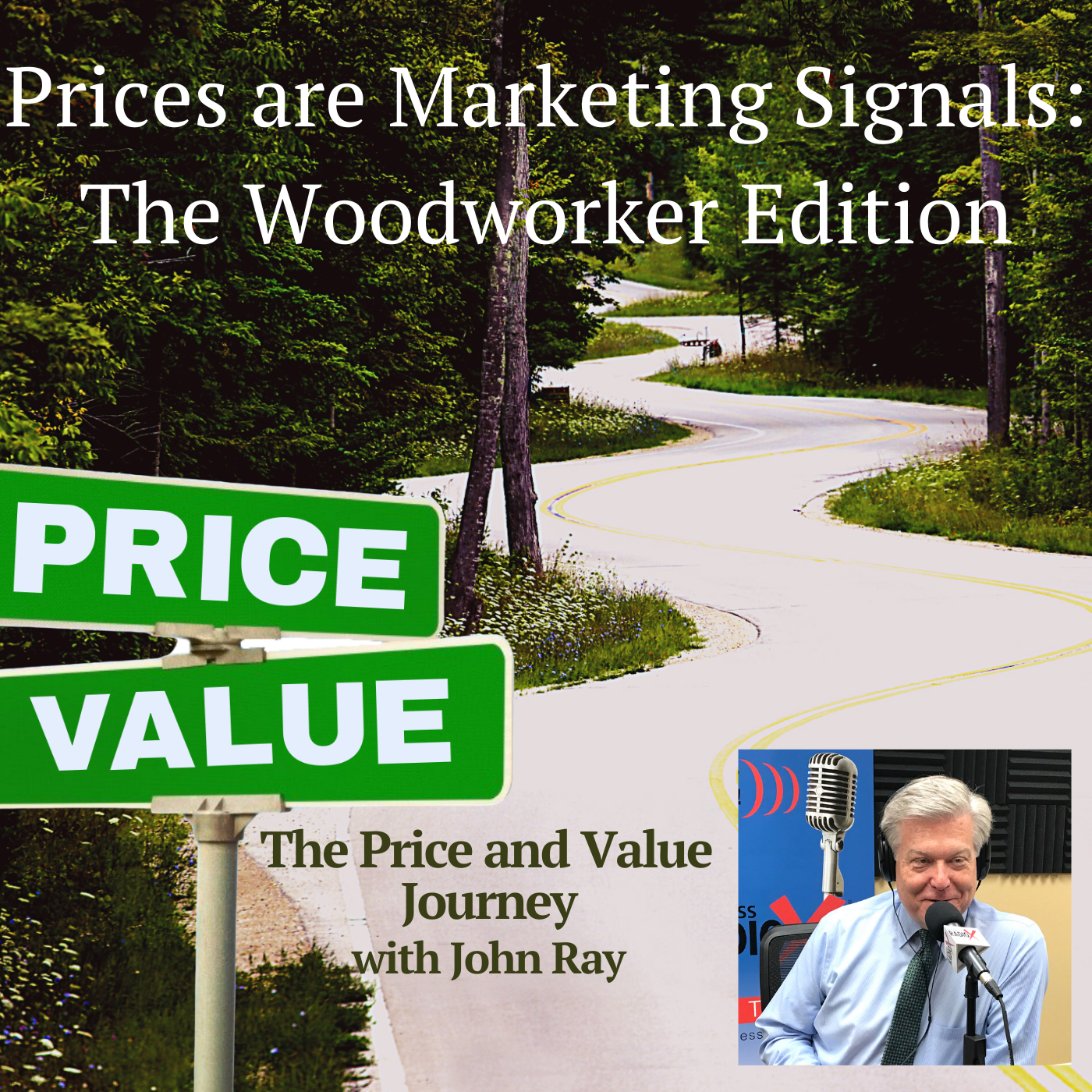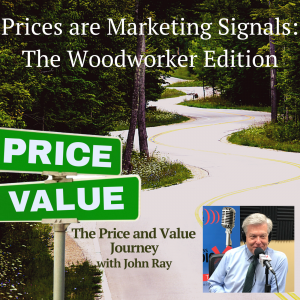

Prices are Marketing Signals: The Woodworker Edition
Prices are marketing signals. Prices send messages of quality, and sometimes prices send a signal you didn’t intend: that your service is inferior in some way. A master woodworker’s story illustrates the point. The Price and Value Journey is presented by John Ray and produced by the North Fulton studio of Business RadioX®.
TRANSCRIPT
John Ray: [00:00:00] Hello. I’m John Ray on The Price and Value Journey. A few years ago, I gave a presentation to a group of business owners on pricing and specifically how pricing is the most important driver of revenue and profit growth in a business.
John Ray: [00:00:15] To understand pricing, it’s important to understand the value equation customers sort through as they evaluate a purchase. Regardless of whether they consciously realize it or not, clients weigh a comparison in their head. Does the value received from this product or service exceed the cost of the purchase? Now, that value could be tangible or intangible. Most often it’s a combination of both.
John Ray: [00:00:43] After my presentation, I received a comment from Hans Meyer. He’s a friend of mine who, at the time, was in the office products business. But on the side, Hans is a phenomenally talented wood craftsman. In fact, he does that work fulltime now that he’s retired. He makes a variety of wood decorative items, toys, puzzles, teaches other craftsmen, and exhibits at weekend trade shows.
John Ray: [00:01:12] Hans shared with me that he started making wood fret crosses. Now, wooden fret crosses can be extremely ornate and intricate. They’re beautiful works of art. Hans had made several large ones, which he had priced at $40 to 50 each. Despite their beauty, the crosses were just not selling. And in turn, this led to another problem, these crosses had been to eight or ten different craft shows and had not sold.
John Ray: [00:01:43] Well, finally, out of frustration at one show where, again, the crosses were not selling and not wanting to have to lug them back home yet again, Hans decided to mark them down and get rid of them. With pen in hand, he started changing prices. What are you doing? A voice called urgently from the next booth. It was a lady who was exhibiting her crafts next to Hans and she was curious.
John Ray: [00:02:10] Hans told her the saga of his crosses and how he wanted to mark them down to get rid of them. “No,” she replied emphatically, “do not do that. Absolutely not.” Hans was exasperated, he said, and he handed her the pen, “Okay then, you price them.” Well, she took the pen and she made new tags for the crosses, pricing them from $125 to 150 each. During that same show, Hans sold three crosses at the new higher prices to three different customers.
John Ray: [00:02:48] Hans now routinely sells these ornate crosses from $175 to 225 each. That’s about four times more than before his fellow exhibitor took that pen and in just a few short moments completely transformed the profitability of these products.
John Ray: [00:03:08] As business owners, we need to understand that our price is sometimes interpreted as a signal by customers. A signal of quality or a lack thereof. A readiness to discount or markdown may be interpreted by the client as an admission that the product or service really doesn’t have that much value after all. In such cases, discounts may not actually drive a sale. On the contrary, the signals sent by a discounted or low price may drive the client away and into the arms of another provider whose higher price signals better quality.
John Ray: [00:03:47] In the case of Hans and his decorative fret crosses, a higher price reinforced in the minds of buying clients what they came to the craft show to purchase, an intricately carved handmade item, handmade by a master craftsman. Hans’ original much lower price may have been interpreted by potential buyers as a signal these items were not of much quality and craftsmanship.
John Ray: [00:04:16] If you enjoy a craft beer or wine and you’re not really a connoisseur, think about how you order in a restaurant confronted by a list of beers and wines. Some of which you’ve never had before. Some of which you’ve never heard of. What’s your first impression of the $8 glass of craft beer you’ve never heard of compared to that $2 Budweiser draft? The former has to be good if it’s $8, right?
John Ray: [00:04:45] Now, you don’t have to imbibe to be subject to this phenomena. What about that delivered pizza from the national chain which you purchased with a discount you accidentally found online and which comes in a box with more coupons taped on top? How does your perception of the quality of that pizza compare in your mind to the more expensive version you get in a sit down Italian restaurant, which, not only doesn’t deliver, but doesn’t discount?
John Ray: [00:05:15] This dynamic is not just true in extremely subjective products like arts and crafts or food and drink. What’s your immediate perception of the experience, intellectual depth, advice, and service quality of the attorney advertising on a billboard for a $199 divorce versus an attorney who asks for a $10,000 retainer to begin the divorce process? Absent any other information, which attorney would you think offers the best quality service?
John Ray: [00:05:53] Understand that your price is a signal to potential buyers. Price your service with care. Those prices may be interpreted in ways you never considered and can reveal much more about your service than you can imagine.
John Ray: [00:06:10] I’m John Ray on the Price and Value Journey. Other episodes in this series can be found at pricevaluejourney.com or on your favorite podcast app.
John Ray: [00:06:21] I want to give a shoutout to Hans Meyer. If you’d like to see more of his work, go to hanspuzzles.com, that’s H-A-N-S-puzzles.com Hans is an outstanding woodworker who makes not only puzzles and fret crosses, but all manner of unique handcrafted wood products.
John Ray: [00:06:46] If you’d like to connect with me directly, you can send me an email, john@johnray.co. Thank you for joining me.
About The Price and Value Journey
The title of this show describes the journey all professional services providers are on: building a services practice by seeking to convince the world of the value we offer, helping clients achieve the outcomes they desire and trying to do all that at pricing which reflects the value we deliver.
If you feel like you’re working too hard for too little money in your solo or small firm practice, this show is for you. Even if you’re reasonably happy with your practice, you’ll hear ways to improve both your bottom line as well as the mindset you bring to your business.
The show is produced by the North Fulton studio of Business RadioX® and can be found on all the major podcast apps. The complete show archive is here.
John Ray, Host of The Price and Value Journey

John Ray is the host of The Price and Value Journey.
John owns Ray Business Advisors, a business advisory practice. John’s services include advising solopreneur and small professional services firms on their pricing. John is passionate about the power of pricing for business owners, as changing pricing is the fastest way to change the profitability of a business. His clients are professionals who are selling their “grey matter,” such as attorneys, CPAs, accountants and bookkeepers, consultants, marketing professionals, and other professional services practitioners.
In his other business, John is a Studio Owner, Producer, and Show Host with Business RadioX®, and works with business owners who want to do their own podcast. As a veteran B2B services provider, John’s special sauce is coaching B2B professionals to use a podcast to build relationships in a non-salesy way which translate into revenue.
John is the host of North Fulton Business Radio, Minneapolis-St. Paul Business Radio, Nashville Business Radio, Alpharetta Tech Talk, and Business Leaders Radio. house shows which feature a wide range of business leaders and companies. John has hosted and/or produced over 1,100 podcast episodes.














